

The Who Shelf
Doctor who book & audio news, dalek mark iii travel machine: combat training manual.
One of the first things I covered on this blog was the TARDIS Manual back in 2018 and now the same team of writers and artists are back with the Dalek Combat Training Manual – a visual breakdown of the Doctor’s arch foes.
This combat manual is a collation of vital intelligence gathered by Time Lords over centuries. It is invaluable to anyone engaging the Daleks in battle. Know your enemy. Cover Blurb

The team of Richard Atkinson, Mike Tucker and Gavin Rymill are back together for this release with Atkinson and Tucker on writing duties and digital artist Rymill handling the visuals.
In particular, Rymill 3D modelling work made the TARDIS manual a particular treat, with details like Missy’s TARDIS console room. There’s no shortage of easter eggs here either, with insanely elaborate drawings and cross-sections, including the city on Skaro circa The Magician’s Apprentice and seemingly every model of Dalek ever depicted on screen, recreated in loving detail.

As frequent contributors to the worlds of Doctor Who, Atkinson and Tucker have lent their unique storytelling sensibilities to the book. As with the visuals, these have references to obscure Doctor Who trivia threaded neatly throughout. We also get the “field reports” – breakdowns of Dalek episodes both classic and modern.

It’s a credit to Tucker and Atkinson that they can retell old stories with the tone of military detachment while also making the narrative extremely compelling. As well as inventing backstory for the things we saw onscreen but went unexamined. I mean, where else are you going to find out why the Recon Dalek from 2019’s Resolution took some creative liberties with the design of his casing? Sure, it could just be that it was working with local materials. But isn’t it more fun to discover that he was emulating an early Dalek design adapted for reconnaissance? The book is full of little things like this.

If you liked the TARDIS Manual, this is exactly what you’d expect and exactly what you want. If, like me, you’re less interested in the cold data and more in narrative then this is a nifty accompaniment to Dalek stories with its background details. Either way, the love and effort that’s gone into this tome means it’s well worth checking out.
What’s your favourite Dalek variant? Let me know in the comments.
Leave a Reply Cancel reply
Your email address will not be published. Required fields are marked *
Notify me of follow-up comments by email.
Notify me of new posts by email.

Know your enemy with the Dalek Combat Training Manual
October 21, 2020
As one of the Time Lords’ most notorious enemy returns to Doctor Who this festive season, BBC Books announces an all-new comprehensive user’s guide to the Daleks, with technical information and drawings, case histories, and more.
Pre-order your copy of the Dalek Combat Training Manual now, ahead of its release on the 18th February 2021.

The Daleks are the most evil creatures ever created – genetically engineered mutants encased in a machine that is optimised to kill. They hate all other life forms and will stop at nothing to destroy those who stand in their way – their single-minded imperative? To become the dominant species in the universe.
The Dalek Combat Training Manual collates intelligence gathered by Time Lords over centuries of raging wars through space and time and is invaluable to anyone engaging the Daleks in battle. It offers the user an in-depth guide to their construction, their strategies and how they can be defeated.
Readers can discover diagrams of Dalek spacecraft, insights into the many Dalek factions, a history of the Time War, detailed analysis of their creator Davros, and much more.
More on Products
More from the whoniverse, more from read and watch, from the store.
Not logged in
- Contributions
- Create account
Mark III Travel Machine
- Create talk
Page actions

The Mark III Travel Machine was Davros 's optimum design for the travel machine to house his genetically engineered Kaled mutants . He would call his invention a Dalek , an anagram of the word Kaled , to reflect the reconfigured Kaled life form within. The term would come to be used to refer to the life form as well as the machine . ( PROSE : Dalek Combat Training Manual , TV : Genesis of the Daleks ) As the Fourth Doctor noticed, ( TV : Genesis of the Daleks ) the Mark III was primitive compared to later Dalek casings. ( PROSE : Davros )
History [ [edit] ]
Development [ [edit] ].

By one account, Davros' chair was the Mark I Travel Machine , and his initial Dalek designs were the Mark IIs . ( PROSE : The History of the Daleks ) Another account had Davros present an early prototype machine before he had constructed his own advanced chair, after which he unveiled Dalek One . ( PROSE : Davros Genesis ) In any case, the Daleks were later perfected by Davros in the Mark III Travel Machine. ( TV : Genesis of the Daleks )
By another account, Davros's Mark I Travel Machine was not his chair but a prototype casing of the first Dalek that he created, an experimental life support unit modeled after his own chair. Besides the transplanted Thal brain, it included a life support matrix, an optical stalk, feeding tubes and was activated by a power conduit with only 92% distribution. ( AUDIO : Guilt ) According to the Dalek Combat Training Manual , Davros abandoned this prototype and then his next model before settling upon the Mark III travel machine . ( PROSE : Dalek Combat Training Manual )
In contrast to the earlier models, the Mark III worked with several different power sources, allowing them greater mobility and not restricting them to the static electrical power their prototypes used. A ring of solar cells was constructed about the midsection of the casing. In cases of need, there would be a battery pack inside the casing. An optional addition, useful for overcast areas, was a small dish that could be attached to the back of the Dalek to collect broadcast power. ( PROSE : The History of the Daleks )
Later history [ [edit] ]

The Time Lords understood that "the original Dalek prototype" had a toughened grey coating, bonded to the Dalekanium shell and black sensor globes . This design was replicated for later design units with variant coatings resulting in different shades of grey. The Time Lords identified nine distinct "Types" of Dalek casing, with the grey Daleks being designated as Type IV following the Type I , slatless silver Daleks with "low frequency" blue sensor globes, the Type II , silver Daleks with solar energy collection discs and enlarged fenders , and Type III Dalek , silver Daleks modified with slats. The Type IV was followed by the Type V Dalek , silver Daleks with "multiphase" black sensor globes. In defiance of the Supreme Dalek , Davros himself would create a new Dalek race, the "Type VI" Necros Daleks , which he refined with the "Type VII" Imperial Daleks . Bronze Daleks were designated "Type VIII" and believed to have been developed for the Last Great Time War , with the Time Lords describing them as the ultimate warrior.
The New Dalek Paradigm established in the post-Time War universe used a new casing model designated as "Type IX", ( PROSE : Dalek Combat Training Manual ) but a series of defeats at the hands of the Eleventh Doctor led to this casing falling out of favour and being replaced by the older Bronze Daleks for the Resurrected Dalek Empire . The Prime Minister of the Daleks deemed the bronze design to be more likely provoke the most fear throughout the universe . ( PROSE : Dalek: The Astounding Untold History of the Greatest Enemies of the Universe )
- Travel Machines

- Recent changes
- Random page
Topical pages
- Next season
- Latest episode
- Fifteenth Doctor
- Ruby Sunday
- The Goblin King
- Carla Sunday
- Fourteenth Doctor
- Donna Noble
- Tales of the TARDIS
Other useful pages
- Main episode list
- Weeping Angels
- Regeneration
- Request Videos
- Help + Community Policies
- Upload images
- Explore special pages
- Browse properties
User page tools
- What links here
- Related changes
- Printable version
- Permanent link
- Page information
This page was last edited on 30 March 2024, at 19:49 (UTC). Last edited: 19:49, 30 March 2024 (UTC)
- Content is available under CC BY-SA 3.0 unless otherwise noted.
- Privacy policy
- About Tardis Wiki
- Disclaimers
- Mobile view
- Prototype Travel Machines
- Mark 1 Travel Machine
- Mark 2 Travel Machine
- Mark 3 Travel Machine
- Mark 4 Travel Machine
- Mark 5 Travel Machine
- Mark 6 Travel Machine
Dalek Travel Machines - Mark 3 Travel Machine
Generation 01 , Generation 02 , Generation 03 , Generation 04 .
At the very end of the Kaled-Thal war, Davros revealed the Mark Three Travel Machine to the assembled members of the Kaled Science Elite. It was shortly after this reveal that the name "Dalek" was first used to refer to the Kaled mutant and its habitation casing. This machine was the first of the casings to feature an internal power supply, although external sources of power could still be drawn upon to supplement this supply. This was the most commonly used casing utilised throughout the history of the Dalek race up until the Time War against Gallifrey, and a number of cosmetic variations to the basic design have been sighted over the years. Variations included the number of rings on the eye-stalk, detail between the arm sockets and different designs of luminoscity dischargers. Following the Dalek Civil War, the basic design of the casing was improved on by implementing elements of the design of the Mark Four casing used by Davros' Imperial Dalek Faction .
This casing featured stronger armour than either of the previous designs. This was primarily due to Davros' new vision of the Dalek as a one-mutant tank as well as a means of survival for the Kaled people. Exchangeable manipulator arms made the casing a versatile tool for its occupant. The standard "sucker" attachment, seen on the vast majority of Dalek units included a Data-probe that could be extended to interface with Dalek technology. This probe was also capable of adapting to interact with alien technology. The sucker utilised suction and magnetics to allow the Dalek to carry objects with this attachment. The left attachment was almost exclusively a sophisticated energy weapon. Both arms could be swapped for other tools when required.
As with previous designs, fifty-two (52) sensor globes fed environmental data to the central computer. These had been updated to include simple life-sign detectors. The occupant knew when life is around, if not precisely where it was.
This construction of the Dalekanium shell was such that the occupant could withstand submersion in liquid and burial under solid materials. The casing did not protect against sudden extremes of temperature, but the casings systems were capable of withstanding changes that occurred slowly. Evidence also suggests that the mutant within a Mark Three casing could be drowned if liquid was forced into its life support chamber.
As with the Mark Two Travel Machine , the computer systems were located within the dome section of the casing. This system was more advanced than that of the Mark Two casing and was continually upgraded during the course of the casing's use throughout history. This advanced computer system allowed the mutant quicker access to data and included an internal communications link with other units in addition to a distress signal / homing beacon that was activated either by the mutant itself or when the dome’s seal was broken without the correct code being sent. The habitation module sat within the middle "neck" section of the casing and the mutant had direct control of whichever arm attachments were installed. Beneath the habitation module was located the nutrient tank that fed and supported the casing's occupant.
Within the skirting section, an advanced power generator was situated at the heart of the machine. This generator was supplemented by external panels around the shoulders that were capable of extracting energy from the environment, in particular solar radiation. In addition, Psychokinetic energy was used as a power source when traditional means fail, though this only provided enough energy to power the motive unit and life-support systems of the casing. The motive unit of the Mark Three Casing allowed for faster movement than previous designs and the increase in available power reserves allowed the motive unit to lift the machine up to twenty five centimetres from the surface along which the unit was travelling. The unit could thus travel up uneven surfaces by raising and tilting backwards and propelling upwards.
A prototype of this casing was seen amongst early Pioneer fleets which contained an advanced battery, but no internal power plant. Energy must be collected from external sources and the battery charged. The Travel Machine would then be able to operate independently for a limited amount of time. This casing was issued to Generation 02 explorer units to enhance their efficiency when away from the main Dalek fleet.
The Chase, Genesis of the Daleks, War of the Daleks, Dalek Empire 01-04. Prototype – Power of the Daleks.

Tank Mark I
- Post author By David.B
- Post date September 15, 2016
- 16 Comments on Tank Mark I

United Kingdom (1916) Heavy Tank – 150 Built

100 years of armored warfare
The Tank Mark I marked both the dawn of armored warfare and the start of the whole tank lineage that would soon find its treasured place in almost all armies of the world. It is important to remember that, although a weapon of war, perfected in the art of death and destruction on land, the tank also saved lives, thousands of them. This started right in 1916, when the first Mark Is helped restore the confidence of the exhausted and depressed fighting men, after facing years of being treated like meat for the butcher. This was the weapon that would unlock the stalemate and put an end to trench warfare.

The “Little Willie”
The Mk.I tank was the first operational tank in the British army and in the world. It was based on the “Little Willie” (The Lincoln machine) project, supported by the Landships Committee, headed by Walter Wilson and William Tritton. It was largely an attempt to overcome the previous model’s issues. One of the solutions was to avoid adding a turret and mounted the guns in sponsons instead. The Little Willie , also known as the “Lincoln machine number one”, was tested and modified, and the lessons were taken in account for the development of the Mark I and its prototype, called “Big Willie” or, more commonly, “Mother”.
“Mother”, the production prototype
In December 1915, the final prototype was ready for the first trials, which took place in April 1916. It was named officially “His Majesty’s Land Ship Centipede”, but was know colloquially as “Mother” or “Big Willie”, as a joke directed towards the German Kaiser and the crown prince, both named Wilhelm. In the meantime, the “Tank Supply Committee” succeeded the Landship Committee, under the chairmanship of Albert Stern. Other members included Ernest Swinton, the head of the committee, General Haig, who acted as a liaison officer, Hugh Elles who would later become the commander of the tank force in France. The trials were held up in an impressive reconstruction of no-man’s land with trenches, parapets, craters and barbed wire, and impressed all officers except the Secretary of War, Lord Kitchener. Despite of this, an order was secured for 150 tanks in two batches, with one order being issued 0n 12 February 1916 and another on April 23.

Propulsion relied on a six cylinder petrol engine at the rear of the hull, with no compartmentalization, due to the transmission system tunnel, which ran through the tank and, more importantly, because, at that stage, the engine was relatively untested and finicky enough to force engineers to need to be able to get their hands on the engine just in case. In addition, the engine had to push quite hard to carry the 28 tons of steel with its just 105 horsepower, with a crushingly low of 3.7 hp per tonne. Not surprisingly, the burden was made greater by the incredibly sticky nature of the mud, which was shown by recent studies to just stick to metal, which meant a tremendous force was required to extract whatever was plunged in it. At least in the case of the tracks, the flat shape and serial arrangement made it more likely to “surf” on the surface, although taking along a large amount of mud in the process. Being clogged in a sinkhole was just the level of effort which the valiant little Daimler was not ready to undertake. Breakdowns were commonplace and ruined the early stage of the assault, largely diminishing the number of tanks that just had the luck to make their way into the no-man’s land and reach the destination. Also, the engine not being separated from the fighting compartment proved ruinous for the crew, which fell ill quite quickly, but that feature remained unchanged until 1918. The general staff didn’t see this sickness as a limitation either, given the relatively short distance which had to be crossed between opposing trenches. A mobility aspect which was incorporated into the design concerned the removable sponsons, allowing the tank to be narrower and thus, providing easier transport by rail.
The crew comprised eight men, of which two were drivers (one for the gearbox and the other for the brakes) and two others controlling the gears of each track. This system needed perfect coordination, which was difficult due to the noise inside and the protective leather helmets they used. The four others were gunners, serving the six-pounders and the machine guns, depending on the armament. 50% of the Mk.Is were armed with two guns in the sponsons and three machine-guns (two in the sponsons, one axial in the hull), named “males”, and the other half were “females”, armed with five machine-guns. These were either Vickers models or the 8 mm (0.31 in) Hotchkiss air-cooled equivalents. The tanks were quite big, weighing 28 tons with an eight meters long hull and an overall length of nearly ten meters with the additional tail wheel, another feature kept from the Little Willie . It was designed to help crossing very large trenches, but later proved impractical and was dropped.
No less than 150 Mk.Is were built at William Foster & Co. of the Lincoln Metropolitan Carriage and Metropolitan Carriage, Wagon & Finance Co. at Wednesbury. The first order of 100 was increased to 150 in April 1916, acting as a pre-series for further mass-productions. The Foster deliveries concerned 37 males, while Metropolitan Carriage, Wagon, and Finance Company, of Birmingham, delivered 113 Tanks, including 38 “males” and 75 “females”. Later on, two rails were mounted over the hull to handle a wooden beam, used for unditching. The first were ready in a hurry and deployed in August, just in time for the Somme Offensive. From the end of 1917 and until 1918, some of the surviving ones were converted as signal tanks with a large antenna at the base of the driver’s cab, participating in the battle of Cambrai. Others were converted as supply tanks.
Succession: the Mk.II and III
As the Mark I showed many limitations, the next batch of 50 tanks (25 females and 25 males) were built at Foster & Co and Metropolitan for training purposes only. There were some claims about their unhardened steel plates, but all data seems to show that the Mk.IIs were regular Mk.Is with a few modifications for training purposes. Some 20 were sent to France for advanced training and those left remained at the Wool training ground in Dorset. However, in 1917, there weren’t enough tanks operational for the offensives planned in April 1917 near Arras, and twenty surviving Mk.Is and all the Mk.IIs remaining in Britain were put in action (despite some protests), suffering high casualties, mainly due to the new armor-piercing bullets the Germans employed. The Mark IIIs were training tanks as well (the great improvements were still planned for the Mk.IV ) and were all fitted with Lewis machine guns in smaller, lighter sponsons. Otherwise, few changes were visible at the beginning, as this batch of 50 vehicles was designed to incorporate all the Mk.IV improvements. Deliveries were slow and none left Great Britain.
The Mark I In Action
Their first operational use was in September at Flers-Courcelette, but this first attempt was a near disaster. Most of the tanks broke down on their way, others bogged down in the mud. However, despite the lack of training of their crews, some managed to reach their designated objective, if only too few. Only 59 were part of this attack, most of them being captured afterwards by the Germans. The first issues quickly arrived at the War Office. When they appeared however through the fog, they had an uncanny psychological effect on the German troops, which fled their trenches, leaving their machine guns. The distant roar and clinging of the tracks, and later the slow-moving masses emerging from the fog which resembled nothing built yet were enough. But their ability to take punishment and return fire was compelled by the fact the Germans were caught completely unaware of their existance. A real surprise achieved by the well-guarded secret behind the name that stuck ever since, the “tank”.
The noise, the smell and the temperature that reached nearly 50 degrees Celsius were just unbearable. There were powerful emanations of carbon monoxide, cordite, fuel and oil vapors, all made worse by poor ventilation. The crews often opened the narrow door situated just behind the sponson, in an attempt to get some fresh air in. With poor training and almost no internal communication, steering was enormously difficult, resulting in mechanical over-stress, causing many breakdowns.
Another factor was the petrol engine, overwhelmed by the weight of the hull combined with the very sticky, heavy mud typical of the region, something that was rediscovered when excavating and experimenting with the supposed battlefield of Agincourt. Coordination between the tanks also proved inadequate, theoretically by using a set of fanions, flags, lamps, semaphores and other devices inspired by navy practice. There was no radio on board. Pigeons were used instead to report positions and status with the General Headquarters.
Protection issue
Crew security was also an issue inside the tank. If the 8 mm (0.31 in) plates were proven bullet proof, each impact produced mini-shrapnel inside the hull, injuring anybody inside. Following the first reports, thick leather jackets and helmets, or a combination of leather and chain-mail, were provided to the crews. Spall liners only appeared decades later.
Surviving example
David Fletcher – Osprey British Mark I Tank 1916 Wikipedia Mark I tank The “Big Willie”, or Mother on militaryfactory The Mark I on tanks-photographs About camouflages and liveries (landship II) Tank-Hunter.com Mark I tank
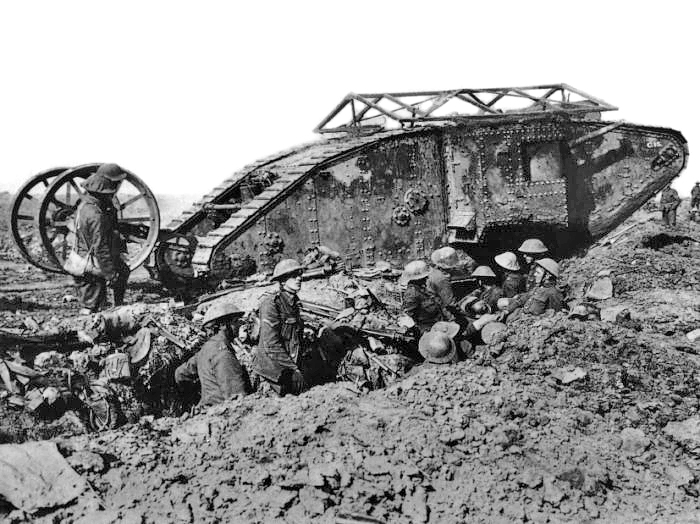
By Craig Moore
The First World War’s fierce battles saw the need to develop military technology beyond anything previously imagined: as exposed infantry and cavalry were mowed down by relentless machine-gun attacks, so tanks were developed. Stunningly illustrated in full colour throughout, Tank Hunter: World War One provides historical background, facts and figures for each First World War tank as well as the locations of any surviving examples, giving you the opportunity to become a Tank Hunter yourself.
Buy this book on Amazon!
Tank Encyclopedia's Creator, webmaster and illustrator since 2010.
16 replies on “Tank Mark I”
This is the very best site of its kind on the internet. Everything you want to know about tanks is here. A lot of work has been done to put this site together. well done.
What a great informative website!
Thanks Ben! We are continuously updating, researching and writing new articles.
Haha, just notice the date this was posted is September 15, 2016. the date of the battle of Fler-Courcelette is September 15, 1916.
Hello, I noticed there are multiple links on the “Little Willie” which leads to a nonexistent page, just thought I’d give a heads up!
Fixed, thank you!
what about the version with the red and white on front?
This article Covers the Mark I vehicle, the white and Red markings were not introduced until later when the Mark I had been superseded by the Mark IV and V -TE Moderator
The you are the best on the internet Thank you
Hi all I have a brass uniform button which has the motif of the mark 1 tank. Can anyone tell me what the uniform was accosted with. Obviously it’s not the normal Tank Corp button?
HI i am writing a research paper on the mark tanks and this website was very helpful, thanks to who published this.
Glad these articles can be helpful to you, Jeffrey. Most of the Mark Tanks articles has been rewritten by Craig Moore. Thanks for him. Cheers, David B. TE Manager
Small mistake: Mother had more rivets than later versions: https://drive.google.com/open?id=1AujUk-wk5CbTS_vNNlQ7RK1E2EJ0ZZ_9
Was the page changed, I remember there being more pictures in the gallery
So was the article changed recently cause I remember more illustrations like the German captured tanks and this one with the weird square cameo to hide the peep holes from snipers.
Hi, I was wondering if you have any tips for distinguishing the Mark 1 and the Mark 2 tanks?
Leave a Reply Cancel reply
Your email address will not be published. Required fields are marked *
Save my name, email, and website in this browser for the next time I comment.
Privacy Overview

- University News
- Faculty & Research
- Health & Medicine
- Science & Technology
- Social Sciences
- Humanities & Arts
- Students & Alumni
- Arts & Culture
- Sports & Athletics
- The Professions
- International
- New England Guide
The Magazine
- Current Issue
- Past Issues
Class Notes & Obituaries
- Browse Class Notes
- Browse Obituaries
Collections
- Commencement
- The Context
- Harvard Squared
- Harvard in the Headlines
Support Harvard Magazine
- Why We Need Your Support
- How We Are Funded
- Ways to Support the Magazine
- Special Gifts
- Behind the Scenes
Classifieds
- Vacation Rentals & Travel
- Real Estate
- Products & Services
- Harvard Authors’ Bookshelf
- Education & Enrichment Resource
- Ad Prices & Information
- Place An Ad
Follow Harvard Magazine:
Harvard History & Traditions | 4.4.2014
Mark I, Rebooted
At harvard, howard aiken's computing machine hums briefly back to life..
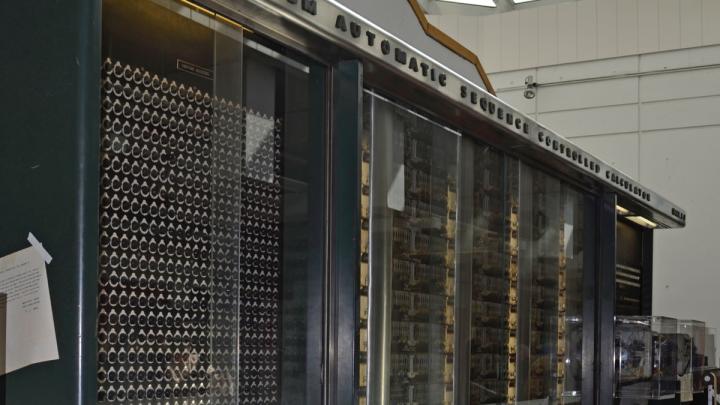
The Mark I , the first programmable computer in the United States, hummed briefly back to life yesterday, 70 years after performing its first calculations. Gears whirred and parts moved back and forth, drawing cheers from the assembled crowd even though no computations were made. Likewise in attentive attendance were dozens of the machine’s electronic descendants: smartphones, cameras, and at least one wearable computer, Google Glass, all bore witness to how far computer science has come.
The brief reboot of the Mark I celebrated the opening of a newly redesigned exhibit centered on the machine. The computational monster was 55 feet long, eight feet tall, and weighed five tons in total, though only part of the machine remains on display in the Science Center lobby. In the 1930s, explained Cherry Murray , dean of the School of Engineering and Applied Sciences, a Harvard graduate student in physics, Howard Aiken, dreamed up the machine as a way to speed up tedious calculations. The Automatic Sequence Controlled Calculator, as the Mark I was originally known, was built by IBM and presented to Harvard in August 1944. For 15 years, it played an important role in U.S. military efforts, solving differential equations called Bessel functions (for which it earned the nickname "Bessie") and running a series of calculations that helped design the atomic bomb.
By its 1959 retirement, the Mark I had carved out a place in computing history—as well as popular culture. “One of the things that I love about this machine is that it embodies, in a very direct, literal way, terms that we’re used to—like the ‘bug’, the ‘loop,’ and the ‘library,’” said Pellegrino University Professor Peter Galison , who directs the Collection of Historical Scientific Instruments . On one occasion, for instance, the Mark II, a descendent of the Mark I, was famously laid low by a moth that became trapped in its inner workings. Programmer Grace Hopper attached it to the operations logbook with the comment, “First actual case of bug being found.”
In the Mark I’s time, few researchers imagined that computers would ever be widely used, remarked Michael D. Smith , dean of the Faculty of Arts and Sciences and himself a computer scientist. Allegedly, IBM chairman Thomas Watson predicted, “I think there is a world market for maybe five computers.” Now, said Smith, “If you grab the undergraduate sitting next to you and empty their pockets and look in their backpack, you’re going to find five computers just hanging out there.”
“We’ve come a long way in the last 70 years in thinking about what these machines can do,” he concluded. “I hope we’ve learned how to apply those lessons for the next 70 years.” With that, a loud, deep hum filled the air as the Mark I churned back to life, signaling its agreement.
For more on computational science then and now, see “ A Toolkit in 0s and 1s .”

You might also like

Harvard Students form Pro-Palestine Encampment
Protesters set up camp in Harvard Yard.

Harvard Coop’s Changing of the Guard
New leadership for a staple Square retailer

Artificial Intelligence in the Academy
Harvard symposium assesses the new technology.
Most popular

The World’s Costliest Health Care
Administrative costs, greed, overutilization—can these drivers of U.S. medical costs be curbed?
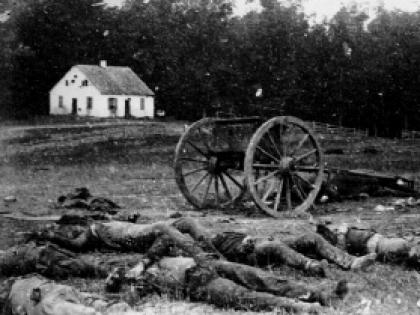
The Deadliest War
Drew Faust speaks on how the Civil War’s astounding death toll reshaped American society.
More to explore

University People
Harvard Cardinal Robert W. McElroy on the Changing Catholic Church
Cardinal Robert W. McElroy on how the Catholic Church has moved towards inclusivity.

AI as Cancer Oracle?
How is artificial intelligence (AI) being used for cancer detection and prevention?

The Harvard Graduate and Early Vegetarian Benjamin Smith Lyman
Brief life of the vegetarian trailblazer, 1835-1920
Mark I Tank
by Dukgyu | Jul 12, 2023 | war machines
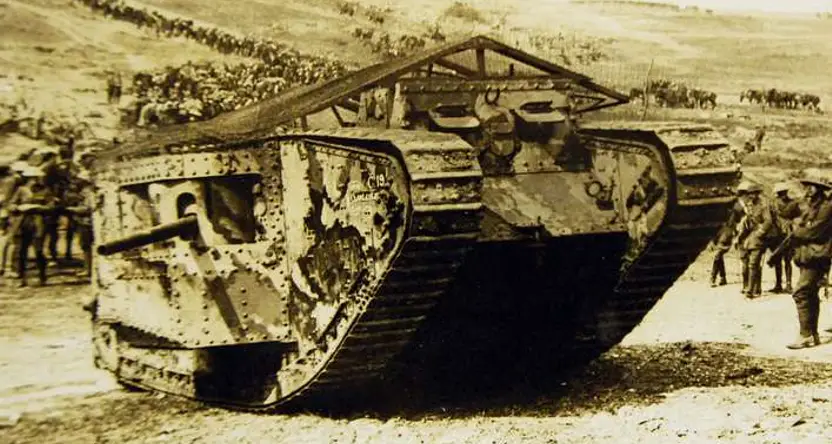
In the chronicles of military history, the Mark I tank stands tall as a revolutionary invention that forever altered the dynamics of warfare. Born amidst the chaos of World War I, this British innovation was not just a new piece of machinery; it was a symbol of radical change, a testament to human ingenuity in the face of adversity. This steel leviathan was designed to navigate the rutted landscapes and trench networks that characterized the Western Front. Prior to its invention, these trenches, a grim hallmark of World War I, had stymied the armies of both sides, leading to a devastating stalemate.

Mark I tank in WW1
However, the introduction of the Mark I tank on 15 September 1916 signified a shift in the tide. Its combination of armored protection, firepower, and all-terrain mobility gave birth to a new era of mechanized warfare, freeing soldiers from the deadly entrapment of trench warfare. The Mark I tank, therefore, became the blueprint for all future tanks, paving the way for successors like the Mark II and Mark IV tanks, right up to the Mark VIII tank. Each iteration, while different in specific design and capabilities, carried forward the legacy of the original Mark I.
The Mark I tank holds a crucial place in the annals of military technology. It demonstrated that necessity, truly, is the mother of invention. In the darkest hours of World War I, it shone as a beacon of hope and marked a profound evolution in how battles would be fought in the years to come. Just as the innovations of Leonardo da Vinci were pivotal in his time, the Mark I tank was, and remains, a watershed in ours.
The Mark I Tank and WW 1
World War I (WW1) saw the emergence of new technologies that forever changed the nature of warfare, among which the Mark I tank was undoubtedly the most revolutionary. The brutal stalemate of trench warfare demanded an innovative solution, and in response, the Mark I tank was born.
The Role of Mark I Tank in WW1
When the Mark I tank was introduced to the battlefield in 1916, it brought an abrupt end to the age of static warfare. The tank, with its caterpillar track design, could navigate the treacherous terrain of the battlefields, clearing paths over trenches and through barbed wire defenses. This ability, coupled with its heavy armor and artillery, made it an intimidating force against the German lines.
The Mark I tank had the element of surprise on its side. Its debut on the battlefield at the Battle of Flers-Courcelette caught the Germans off guard, leaving them ill-prepared to counter this new form of warfare. The tank’s psychological impact was as significant as its physical one, shaking the resolve of the German forces and signaling the beginning of a shift in the momentum of the war.
The Capabilities of the Mark I Tank
The Mark I tank was a force to be reckoned with. Its maximum speed was around 3.7 mph on flat terrain, a slow but steady pace that mirrored the grim determination of the British forces. Despite its lumbering pace, the tank’s unique ability to traverse difficult terrain made it a formidable tool on the battlefield.
The tank’s firepower was equally impressive. The Mark I was armed with two 6-pounder guns and multiple machine guns, making it a mobile fortress capable of delivering a devastating blow to enemy fortifications. Its armored shell could withstand small arms fire and shrapnel, protecting the crew within.
This combination of robust defenses and potent offensive capabilities was unprecedented at the time, and placed the Mark I tank in a league of its own. Just like how Leonardo da Vinci’s inventions broke boundaries in their era, the Mark I tank shattered the conventional wisdom of war, marking a new chapter in military history.
Comparing WW1 Tanks
The evolution of tanks during World War I was a testament to the rapid advancement in military technology, marked by incremental improvements and strategic variations. Among the most significant of these were the British Mark series tanks and the German tanks.
The Mark Series Tanks
The german ww1 tank.
Germany’s response to the British Mark series came in the form of the A7V. Compared to the Mark I tank, the A7V was significantly faster, able to reach speeds of up to 9 mph. It was also equipped with a main gun and six machine guns, offering a formidable mix of firepower.
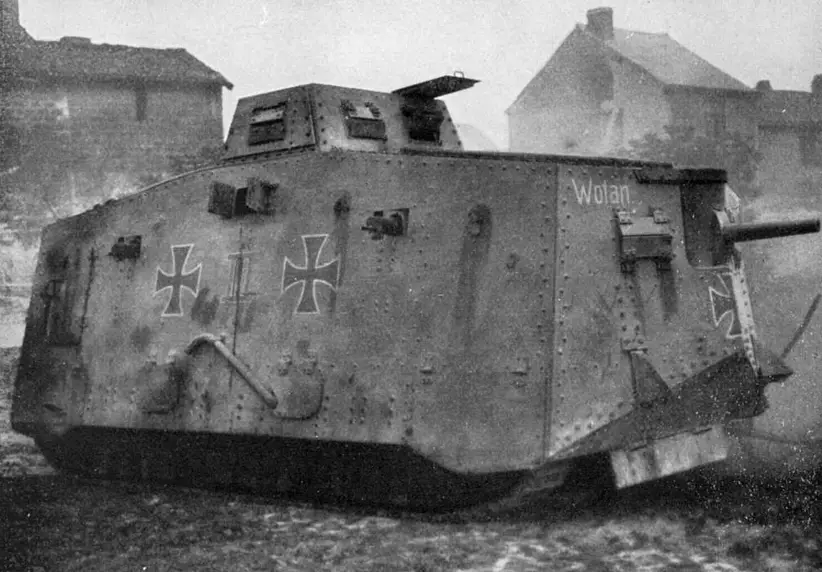
German A7V tank
However, where the Mark I and its successors had the advantage was in their ability to traverse difficult terrain due to their caterpillar track design. The A7V, in contrast, struggled with trenches and uneven landscapes.
From the imposing Mark I tank to the late arrival of the Mark VIII, each iteration reflected a continuous process of learning and adaptation. They stood as symbols of the drive for innovation, much like the inventions of Leonardo da Vinci that pushed the boundaries of what was thought possible. Similarly, the German A7V was a clear testament to the speed with which nations adapted to the changing nature of warfare during this period.
Looking at Tanks Throughout History
The course of history has seen tanks evolve from the rudimentary designs of World War I to the technologically advanced machines of today. While there have been many formidable tanks, there have also been those that were less successful on the battlefield.
The Weakest Tanks
In the realm of WW1 tanks, the French FT-17 often comes to mind when discussing weaker models. While revolutionary in its own right for introducing the classic turret design, the FT-17 was lightly armored and armed only with a machine gun or a light cannon, making it less effective against fortified positions and virtually defenseless against other tanks.
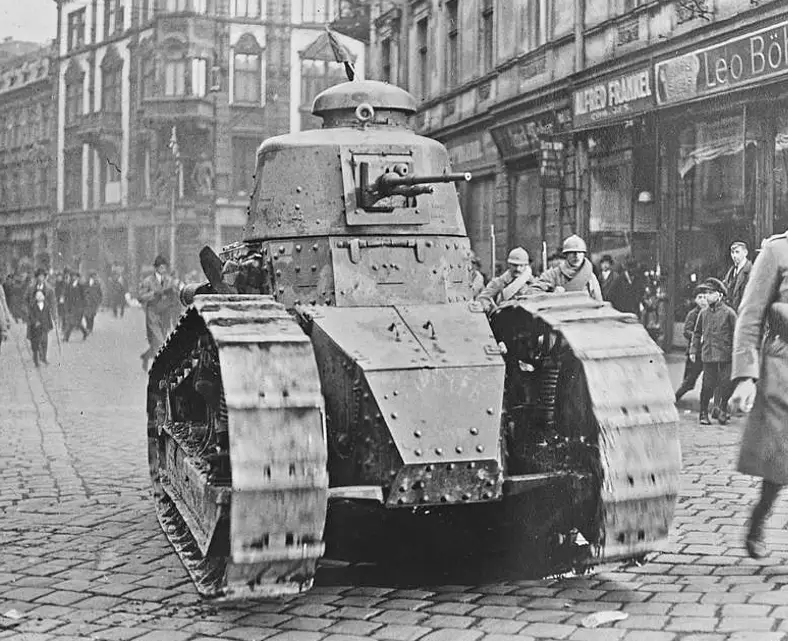
French FT-17 tank
Beyond World War I, the Italian L3/35 of World War II is often cited as one of the weakest tanks ever produced. Despite its impressive mobility, the L3/35 was severely under-armored and under-gunned, with its twin machine guns providing little threat to enemy tanks or fortified positions.
The Most Effective Tanks
When it comes to effectiveness, the T-34, a Soviet tank of World War II, is often hailed as one of the best. It combined a robust design with wide tracks (ideal for the Eastern Front’s harsh terrain), a powerful 76.2mm gun, decent speed, and sloped armor that increased the tank’s defensive capabilities. The T-34 was a testament to the effectiveness of straightforward design and mass production, and it played a crucial role in the Soviet Union’s defensive and offensive operations.
Modern tanks in the post-WWII era, the T-72 stands out as one of the Soviet Union’s most effective tanks. With over 20,000 units produced since its introduction in the late 1960s, the T-72 boasts a powerful 125mm smoothbore gun, composite armor, and a compact design, making it one of the most widely used tanks in history.
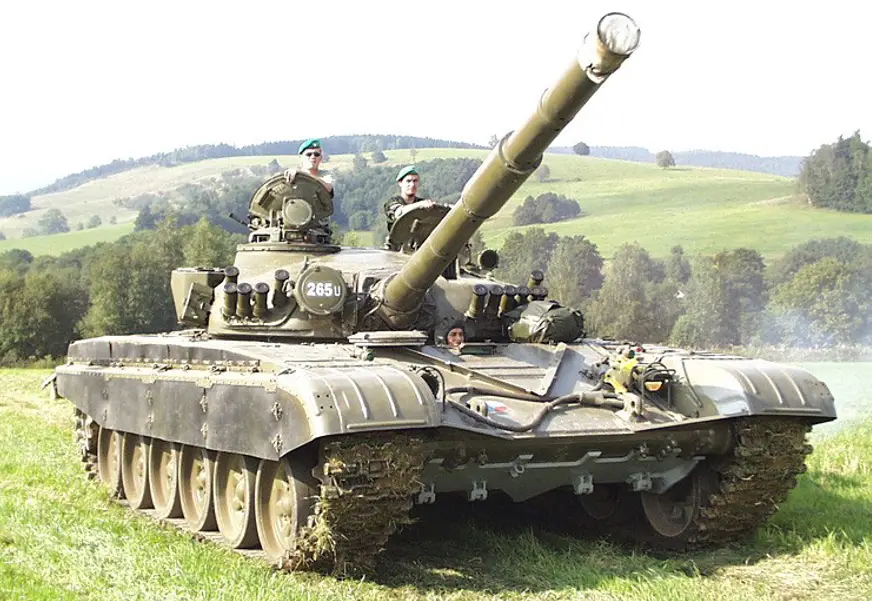
The analysis of tank designs, from the weakest to the most effective, mirrors the trajectory of human innovation. Each model, regardless of its success or failure, represents a stepping stone towards progress, much like how the creations of Leonardo da Vinci helped shape the future of human invention.
The dawn of mechanized warfare was symbolized by the advent of the Mark I tank in World War I. As the first armored vehicle designed for frontline combat, it marked a seismic shift in the tactics and strategy of warfare. The Mark I tank was not just a response to the specific challenges of trench warfare; it was a blueprint for the future.
The significance of the Mark I tank cannot be overstated. It laid the groundwork for successive generations of tanks, starting from the Mark II to the Mark VIII and beyond. It influenced the design of the German WW1 tank and was a precursor to the formidable tanks of World War II.
In the broader context of human history, the development of the Mark I tank shares parallels with the evolution of Leonardo da Vinci’s inventions . Just as da Vinci’s creations pushed the boundaries of what was considered possible in his time, the Mark I tank expanded the horizons of military strategy, forever altering the landscape of warfare. It stands as a testament to the boundless potential of human innovation when faced with the most formidable challenges.
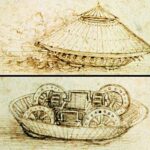
The Helicopter
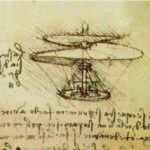
The Mona Lisa

The Last Supper

The Salvator Mundi

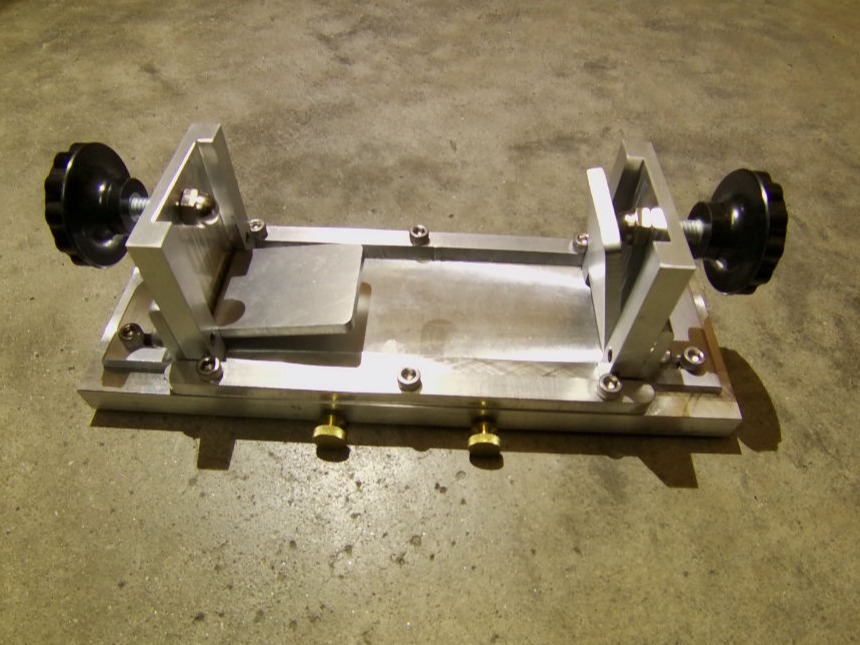
Randolph Mark I Top
Randolph Mk I Top
The Mark I Top is the original rest top produced by Randolph Machine, Inc. The Mark I uses the shooters own "Owl Ear" Bag (available from most shooting supply stores). The bag is held in place by two clamps on the front and back of the base or allowed to lay free between the clamps. Using the adjusting screws on either side, the bag is compressed for a custom fit to the stock. This is a great advantage for shooters using a sporter rifle. The top is interchangeable with either the Front Rest or One-Piece Rest.
Pricing: The Mark I Top costs $150, Owl Ear bag is NOT provided by Randolph Machine, Inc. Due to the extraordinary rising costs of raw materials, Randolph Machine has been forced, regrettably, to raise its prices on rests and tops.
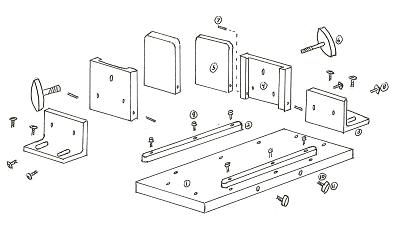
Disclaimers:
Randolph Machine, Inc. warranties its products against defects in craftsmanship and material. However, we do not warranty normal wear and tear or abuse and neglect. *Price is subject to change without notice. Randolph Machine, Inc. accepts most major credit cards from the US only.
© Copyright 2021 Randolph Machine, Inc. All Rights Reserved.
Site was made with Mobirise

I-Mark Dot-Peen and Scribe Marking Machines are Engineered Built Perfect for high volume industrial part marking.

Intuitive Windows Software
Intuitive windows software provides tool tips, help files, online support and software maintenance. The software is always included free with the purchase of I-Mark products.
Network Access
Network access through Ethernet LAN included at no additional cost. Easily program and monitor I-Mark marking machines on the production floor or from the office. Program one or more systems via a remote PC. Advanced fault logging keeps track of marking production.

Automation Integration
The I-Mark marking machines are easy to integrate into production with flexible communications options. Communication protocols include: discrete program selection, fill placeholder data via a variety of protocols, complete remote control and Ethernet IP via implicit messaging.
The I-Mark line wins in the uptime category. The solid head is designed with state-of-the-art controllers. The build includes all machined parts, all linear ways and no plastic components. And of course, is MADE IN THE USA.
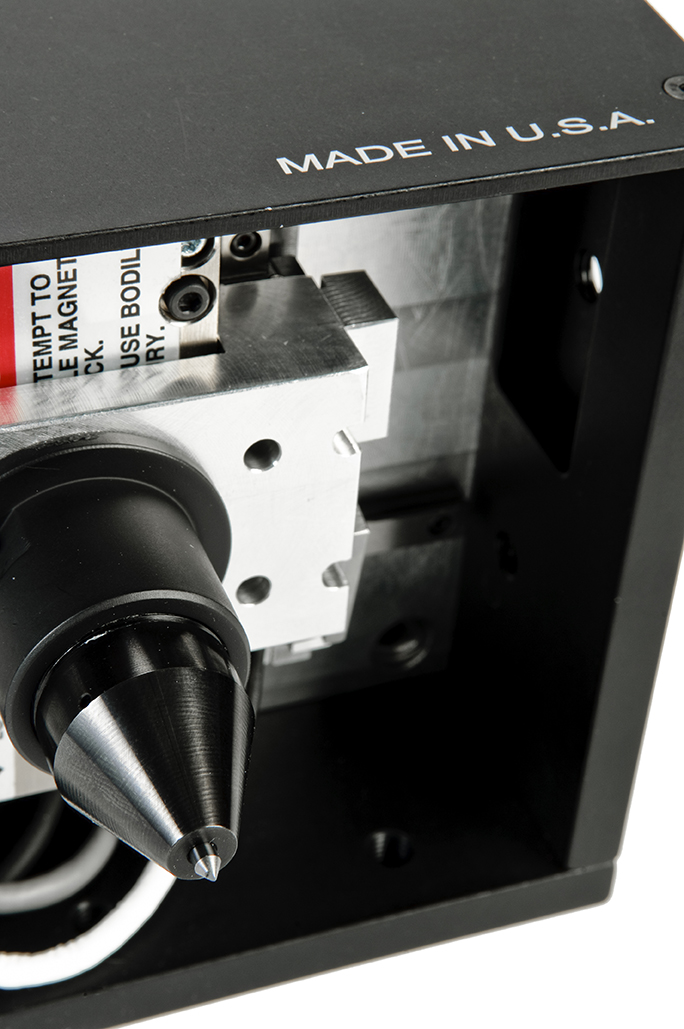
Dual Marking Heads
Control multiple marking heads with one controller. Realize cost savings of 15-25% over the cost of separate units. Mount and install one controller. Simplify communication with the marking heads.
New to Doctor Who or returning after a break? Check out our guides designed to help you find your way!

Talk: Mark I Travel Machine
- Edit source
- View history
Question [ ]
Why is the picture from The Daleks used here? How do we know that story takes place before Genesis ? Steed ☎ 19:28, April 15, 2014 (UTC)

IMAGES
VIDEO
COMMENTS
The Mark I was the name given by Davros to a Travel Machine prototype, the casing of the first Dalek that he created. It was an experimental life support unit modeled after his own chair. Besides the transplanted Thal brain, it included a life support matrix, an optical stalk, feeding tubes and was activated by a power conduit with only 92% distribution. (AUDIO: Guilt) According to the Dalek ...
The Mark I was the name given by Davros to a Travel Machine prototype, the casing of the first Dalek that he created. It was an experimental life support unit modeled after his own chair. Besides the transplanted Thal brain, it included a life support matrix, an optical stalk, feeding tubes and was activated by a power conduit with only 92% ...
The Mark One Travel Machine Casing Fifty-two (52) Sensor globes fed data about the external environment to the Kaled mutation housed in the dome section of the travel machine. The casing featured two arm sockets that could be fitted with a number of different arm attachments, including various manipulation arms, computer interface ports, tools ...
So in another thread I casually referred to a MkII travel machine which for those of you who don't know is what Davros calls the machine part of his Daleks in Genesis Of The Daleks (brilliant story btw) shortly after the first one is completed. ... Mark III, version something-or-other, perhaps. Mark I and Mark II were fairly different but the ...
Dalek Mark III Travel Machine: Combat Training Manual . One of the first things I covered on this blog was the TARDIS Manual back in 2018 and now the same team of writers and artists are back with the Dalek Combat Training Manual - a visual breakdown of the Doctor's arch foes.
To become the dominant species in the universe. The Dalek Combat Training Manual collates intelligence gathered by Time Lords over centuries of raging wars through space and time and is invaluable to anyone engaging the Daleks in battle. It offers the user an in-depth guide to their construction, their strategies and how they can be defeated.
Dalek Travel Machines - Mark 2 Travel Machine In Use By. Generation 02.. Overview. Further research into the Kaled mutation revealed the true end-form of the race to be far smaller than was previously conjectured. Davros and his scientific elite produced designs for the Mark Two Travel Machine that incorporated new refined technologies. Similar in form to the Mark One, but with a smaller dome ...
The Automatic Sequence Controlled Calculator (Harvard Mark I) was the first operating machine that could execute long computations automatically. A project conceived by Harvard University's Dr. Howard Aiken, the Mark I was built by IBM engineers in Endicott, N.Y. A steel frame 51 feet long and 8 feet high held the calculator, which consisted ...
The Mark I was the name given by Davros to a Travel Machine prototype, the casing of the first Dalek that he created. It was an experimental life support unit modeled after his own chair. Besides the transplanted Thal brain, it included a life support matrix, an optical stalk, feeding tubes and was activated by a power conduit with only 92% distribution.
The Mark III Travel Machine was Davros's optimum design for the travel machine to house his genetically engineered Kaled mutants. He would call his invention a Dalek, an anagram of the word Kaled, to reflect the reconfigured Kaled life form within. The term would come to be used to refer to the life form as well as the machine. (PROSE: Dalek Combat Training Manual, TV: Genesis of the Daleks ...
Davros developed a series of Travel Machines to house the mutated remains of his species, the Kaleds. This culminated in the Mark III Travel Machine, which he named Dalek. (TV: Genesis of the Daleks) By one account, Davros' chair was the Mark I Travel Machine, and his initial Dalek designs were the Mark IIs. (PROSE: The History of the Daleks) Another account had Davros present an early ...
Dalek Travel Machines - Mark 3 Travel Machine In Use By. Generation 01, Generation 02, Generation 03, Generation 04.. Overview. At the very end of the Kaled-Thal war, Davros revealed the Mark Three Travel Machine to the assembled members of the Kaled Science Elite. It was shortly after this reveal that the name "Dalek" was first used to refer to the Kaled mutant and its habitation casing.
The Mark I Male tank was armed with a 6pdr gun and three machine guns. On 15th September 1916, 2nd Lieutenant J.P. Clark commanded this Mark I Male tank No.746 in C Company, Section 3, Heavy Section Machine Gun Corps (HSMGC). It was later given the unit number C15. It crossed German trenches and returned to Allied lines at the end of the day.
The Dalek War Machines (COMIC: Genesis of Evil) or Mark II Travel Machines (PROSE: The History of the Daleks) were the type of casing used by the Skaro City Daleks, the earliest form of Daleks encountered by the Doctor.(TV: The Daleks) The Time Lords recorded Daleks using this model of casing as Type I Daleks.(PROSE: Dalek Combat Training Manual) One account dubbed the casing the Mark II ...
The Mark I, the first programmable computer in the United States, hummed briefly back to life yesterday, 70 years after performing its first calculations.Gears whirred and parts moved back and forth, drawing cheers from the assembled crowd even though no computations were made. Likewise in attentive attendance were dozens of the machine's electronic descendants: smartphones, cameras, and at ...
From 1939 to 1944 Aiken, in collaboration with IBM, developed his first fully functional computer, known as the Harvard Mark I. The machine, like Babbage's, was huge: more than 50 feet (15 metres) long, weighing five tons, and consisting of about 750,000 separate parts, it was mostly mechanical. For input and output it used three paper-tape ...
Maximum speed. 3.7 mph (6.0 km/h) maximum [1] British heavy tanks were a series of related armoured fighting vehicles developed by the UK during the First World War. The Mark I was the world's first tank, a tracked, armed, and armoured vehicle, to enter combat. The name "tank" was initially a code name to maintain secrecy and disguise its true ...
The Mark I Tank and WW 1. World War I (WW1) saw the emergence of new technologies that forever changed the nature of warfare, among which the Mark I tank was undoubtedly the most revolutionary. The brutal stalemate of trench warfare demanded an innovative solution, and in response, the Mark I tank was born. The Role of Mark I Tank in WW1
The Mark III Travel Machine was Davros's optimum design for the travel machine to house his genetically engineered Kaled mutants. He would call his invention a Dalek, an anagram of the word Kaled, to reflect the reconfigured Kaled life form within. The term would come to be used to refer to the life form as well as the machine. (PROSE: Dalek Combat Training Manual, TV: Genesis of the Daleks ...
The Mark I Top is the original rest top produced by Randolph Machine, Inc. The Mark I uses the shooters own "Owl Ear" Bag (available from most shooting supply stores). The bag is held in place by two clamps on the front and back of the base or allowed to lay free between the clamps. Using the adjusting screws on either side, the bag is ...
Mark I Travel Machine; Dalek War Machine; Mark III Travel Machine; Categories Categories: Dalek casings + cat; Cancel Save. Community content is available under CC-BY-SA unless otherwise noted. More Fandoms Fantasy; Horror; Sci-fi; Doctor Who; Advertisement. Explore properties. Fandom Muthead
Realize cost savings of 15-25% over the cost of separate units. Mount and install one controller. Simplify communication with the marking heads. Location. 27430 Luckino Dr. Chesterfield Twp. MI 48047. Contact Us. +1 (586) 949 8400. [email protected].
Why is the picture from The Daleks used here? How do we know that story takes place before Genesis? Steed ☎ 19:28, April 15, 2014 (UTC) It was added by an IP user over a year ago. On the AUDIO...